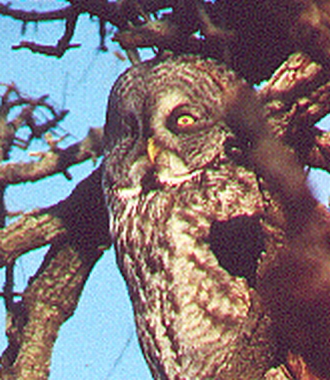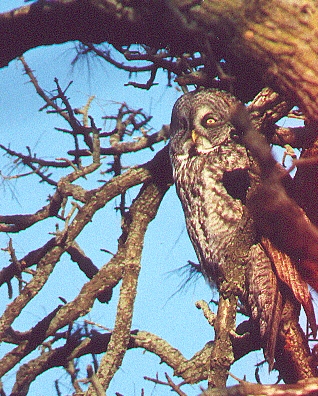|
Strix nebulosa
| Great Gray Owl |

|
Description: 24-33 inches (61-84 cm). W. 5ft (1.5 m) Tail: 11 3/4 - 13 3/4 in.
Average Weights: Male: 34 oz. Female: 46 oz.
A huge, dusky gray, earless owl of the North Woods, with yellow eyes, large facial disks, and distinctive black chin spot
bordered by white patches, resembling a bow tie. This is the largest Owl in North America although it is not the most massive.
Males and females are identical in plumage except that the females may appear slightly darker. Distinctively large facial
disk of light gray with darker gray or brown concentric rings. Facial disk has a thin dark brown border that becomes white
along the bottom edge. Has a black chin with white along the sides that run into the bottom white border of the facial disk
(sometimes referred to as a "white mustache and black bow tie"). Conspicuous white eyebrows and lores. The Great
Gray has a large round head and lacks ear tufts. The general colors of the upper parts are grayish-brown to sooty brown broken
by transverse mottling of grayish-white and dark with scattered short dark streaks. The owl becomes more brown with age. The
bottom portion of the wings (primaries and secondaries) and the tail are barred with dark and light gray. The under parts
are a grayish-white with dark grayish-brown streaks. The iris of the eyes are lemon yellow and the bill is bright yellow to
pale olive green.
Young: Initially the young have a grayish down above and white down below. The juveniles are olive-brown with dark bars
and white spots above. Light gray- white below with dark bars; bold black facial marks. Adult plumage develops over the first
5 months but first year birds have white tipped flight feathers.
Habitat: Coniferous forests and muskeg.
Nesting: 2-5 white eggs in a bulky nest of sticks in a dense conifer.
| Great Gray Owl |

|
Range Resident: from Alaska and across interior Canada south to northern California, northern Wyoming, Minnesota, and Quebec.
In winter wanders rarely southward into northern New England and Great Lakes region. Also in Eurasia.
Voice: Very deep, booming whoo, repeated 10 times or more, and gradually descending the scale.
Habitat: The Great Gray Owl inhabits many types of forests in North America. It favors dense coniferous forests with close
proximity to muskegs, meadows or open fields. This combination allows conifer nesting and roosting along with the abundance
of small rodents that occur in forest openings.
Food and Feeding: The Great Gray Owl's diet consists of almost entirely small rodents. About 90% of their diet consists
of pocket gophers and voles. Other small mammals taken by the owl include mice, squirrels, young rabbits, hares, rats, moles,
and weasels. Also taken are birds, usually small, although there are records of Sharp-shinned Hawks, ducks, and grouse. Small
mammals are usually swallowed whole while larger prey is torn into pieces. The Great Gray can also detect prey under the snow
by sound alone and will dive into the snow for hidden prey. Generally they hunt from a perch by listening and watching. Primarily
a nocturnal and crepuscular owl but may occasionally hunt by day on dark overcast days during the winter months, and while
feeding young.
Breeding: The Great Gray does not build its own nest or modify it in any way other than to potentially deepen the cup.
Most nesting is done in abandoned raptor or crow nests or broken off treetops. Typically clutch size is 3 - 5 eggs but 1 -
9 is possible. In the case of the loss of the eggs, re-nesting may occur two additional times but only one clutch is raised
yearly. Nest sites may also be used for multiple years. The female usually lays 1 egg per day and the incubation period is
generally 28 - 36 days. The male does all the hunting during this period. Although the owlets leave the nest at 20 - 29 days
they are incapable of flight (but can climb trees well) for another 7 - 14 days. Fledging occurs before they are 55 days old
but they remain cared for by the female until 4 - 5 months of age when they begin to disperse. Great Horned Owls are serious
predators of the young although humans are responsible for the greatest losses of the eggs and chicks.
Movements and Life Span: The Great Gray is sedentary with only minor or no movements between summer and winter in many
areas. Each year a limited number of owls will move through dispersals and food scarcity into the Southern Canadian Provinces
and the Northern U.S. It is also regular 10years for irruptions to occur where large movements into the Northern U.S. and
East Coast occur related to harsh winter conditions and prey availability. The Great Gray is a long-lived owl. Banded birds
have been recovered at 13 years of age and captive birds have lived to 27 years of age.
Conservation: The Great Gray Owl is not globally threatened although its population density is generally very low. There
are tremendous variations in its population over extended periods of time related to prey availability. Deforestation, automobile
collisions, development, pocket gopher poisoning, and cattle grazing are potential dangers.
Franks Notes: This winter we had an irruption of Great Gray Owls in Southern Ontario. I was fortunate to be able to see
over 20 and I understand more then 400 were in and around Southern Ontario. I've learned that the irruptions take place about
every 10 years, the last one here was in 1994. The photo here is mine. Problems occurred with photographers getting too close
and stressing birds. Worse was some people fed them, and some birds associated cars with food, with the predictable results
of deaths due to car strikes. Sadly many starved soon after their arrivals, as food was so short when they left. That being
said, it was truly an incredible pleasure to observe this huge owl.
|



